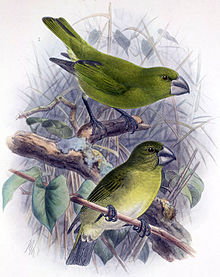
The true finches are small to medium-sized passerine birds in the family Fringillidae. Finches generally have stout conical bills adapted for eating seeds and nuts and often have colourful plumage. They occupy a great range of habitats where they are usually resident and do not migrate. They have a worldwide native distribution except for Australia and the polar regions. The family Fringillidae contains more than two hundred species divided into fifty genera. It includes the canaries, siskins, redpolls, serins, grosbeaks and euphonias, as well as the morphologically divergent Hawaiian honeycreepers.

The rosefinches are a genus, Carpodacus, of passerine birds in the finch family Fringillidae. Most are called "rosefinches" and as the word implies, have various shades of red in their plumage. The common rosefinch is frequently called the "rosefinch". The genus name is from the Ancient Greek terms karpos, "fruit", and dakno, "to bite".
Located about 2,300 miles (3,680 km) from the nearest continental shore, the Hawaiian Islands are the most isolated group of islands on the planet. The plant and animal life of the Hawaiian archipelago is the result of early, very infrequent colonizations of arriving species and the slow evolution of those species—in isolation from the rest of the world's flora and fauna—over a period of at least 5 million years. As a consequence, Hawai'i is home to a large number of endemic species. The radiation of species described by Charles Darwin in the Galapagos Islands which was critical to the formulation of his theory of evolution is far exceeded in the more isolated Hawaiian Islands.

Grosbeak is a form taxon containing various species of seed-eating passerine birds with large beaks. Although they all belong to the superfamily Passeroidea, these birds are not part of a natural group but rather a polyphyletic assemblage of distantly related songbirds. Some are cardueline finches in the family Fringillidae, while others are cardinals in the family Cardinalidae; one is a member of the weaver family Ploceidae. The word "grosbeak", first applied in the late 1670s, is a partial translation of the French grosbec, where gros means "large" and bec means "beak".

The ʻōʻū is a species of Hawaiian honeycreeper endemic to the Hawaiian islands. It has a dark green back and olive green underparts; males have a yellow head while females have a green head. Its unusual beak seems to be adapted to feeding on the fruits of Freycinetia arborea. It has a strong flight which it uses to fly considerable distances in search of this vine, but it will eat other fruits, buds, flowers and insects.

Hibiscadelphus is a genus of flowering plants that are endemic to Hawaiʻi. It is known by the Native Hawaiians as hau kuahiwi which means "mountain Hibiscus". The Latin name Hibiscadelphus means "brother of Hibiscus". It is distinctive for its peculiar flowers, which do not fully open. Hibiscadelphus is in the family Malvaceae, subfamily Malvoideae. Several of the species in this small genus are presumed extinct, as a result of coextinction with their primary pollinators, the Hawaiian honeycreepers.
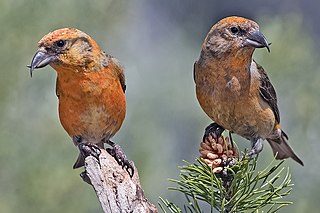
The cardueline finches are a subfamily, Carduelinae, one of three subfamilies of the finch family Fringillidae, the others being the Fringillinae and the Euphoniinae. The Hawaiian honeycreepers are now included in this subfamily. Except for the Hawaiian honeycreepers which underwent adaptive radiation in Hawaii and have evolved a broad range of diets, cardueline finches are specialised seed eaters, and unlike most passerine birds, they feed their young mostly on seeds, which are regurgitated. Besides this, they differ from the other finches in some minor details of their skull. They are adept at opening seeds and clinging to stems, unlike other granivorous birds, such as sparrows and buntings, which feed mostly on fallen seeds. Some members of this subfamily are further specialised to feed on a particular type of seed, such as cones in the case of crossbills. Carduelines forage in flocks throughout the year, rather than keeping territories, and males defend their females rather than a territory or nest.
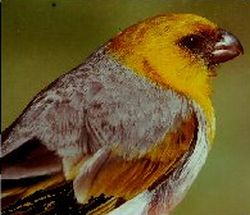
Loxioides is a genus of Hawaiian honeycreeper, in the subfamily Carduelinae.
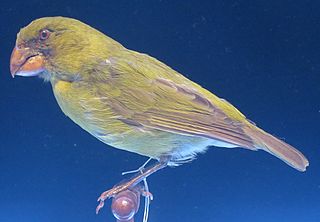
The Kona grosbeak is an extinct species of Hawaiian honeycreeper. The Kona grosbeak was endemic to naio forests on ʻaʻā lava flows at elevations of 1,400–1,500 metres (4,600–4,900 ft) near the Kona District on the island of Hawaii. The species was already very rare when it was first discovered, being found in only about 10 square kilometres (3.9 sq mi), and was last collected in 1894. The reasons for its extinction are not very well known. The genus is known from fossils from Kauai, Oahu and Maui. It was unknown to the Native Hawaiians, and thus a name for it does not exist in the Hawaiian language.

The Lānaʻi hookbill is an extinct species of Hawaiian honeycreeper. It was endemic to the island of Lānaʻi in Hawaiʻi, and was last seen in the southwestern part of the island. George C. Munro collected the only known specimen of this species in 1913, which is housed in the Bernice P. Bishop Museum in Honolulu, and saw the species only twice more, once in 1916 and for a final time in 1918. No other sightings have been reported. They inhabited montane dry forests dominated by ʻakoko and ōpuhe. The Lānaʻi hookbill was monotypic within the genus Dysmorodrepanis and had no known subspecies. Its closest relative is believed to be the ʻōʻū, and some early authors suggested that the Lānaʻi hookbill was merely a deformed ʻōʻū. The Lānaʻi hookbill was a plump, medium-sized bird with greenish olive upperparts and pale whitish yellow underparts. It also had a yellow or white superciliary line and a white chin and throat. The wings also had a distinctive and conspicuous white wing patch. The hookbill's distinguishing characteristic was its heavy, parrotlike bill, which had the mandibles hooking sharply towards each other, leaving a gap between them when the beak was closed.

Hemignathus is a genus of Hawaiian honeycreepers in the subfamily Carduelinae of the family Fringillidae. All species are endemic to Hawaii.

Paroreomyza is a genus of Hawaiian honeycreeper in the subfamily Carduelinae of the family Fringillidae. These birds are endemic to Hawaii.

Rhodacanthis, commonly known as the koa finches, is an extinct genus of Hawaiian honeycreeper in the subfamily Carduelinae of the family Fringillidae. All four species were endemic to Hawaii.

The greater koa finch is an extinct species of Hawaiian honeycreeper in the subfamily Carduelinae of the family Fringillidae. It was endemic to the island of Hawaiʻi.
The wahi grosbeak or Oʻahu grosbeak is a prehistoric species of Hawaiian honeycreeper. The wahi grosbeak was endemic to dry forests on the Hawaiian islands of Kauaʻi, Oʻahu, and Maui. Based on the thickness of its bill it fed on seeds easier to crack than those of the naio, on which the Kona grosbeak fed. The species was already extinct when Europeans landed on the island. Being only known from fossils, its behavior and the exact reasons for its extinction are essentially unknown. Its fossils have been found throughout the islands, but were present in higher concentrations in caves. The bird was smaller than the related King Kong grosbeak by 2 inches (5.1 cm). It had a total length of 9 inches (23 cm).
The King Kong grosbeak or giant grosbeak is a prehistoric species of Hawaiian honeycreeper, that was endemic to Hawaiʻi. It had the largest beak of the three Chloridops species known to have existed. The King Kong grosbeak was described from fossils found at Barber's Point and Ulupau Head on the island of Oʻahu. It was 11 inches (28 cm) long, making it one of the largest Hawaiian honeycreepers. The osteology of the mandible strongly suggests that C. regiskongi was a sister-taxon of Rhodacanthis.

The Laysan honeycreeper, also known as the Laysan ʻapapane or Laysan honeyeater, is an extinct species of finch that was endemic to the island of Laysan in the Northwestern Hawaiian Islands. The bird was first recorded in 1828 and in 1892 received its scientific name from Walter Rothschild, who placed it in the genus Himatione along with the ʻapapane. The specific name, fraithii, refers to George D. Freeth, the self-appointed governor of Laysan, but was misspelled. Rothschild attempted to emend it to freethi in a later publication. This was accepted by most subsequent authors throughout the 20th century, and the bird was also considered a subspecies of the ʻapapane, as H. sanguinea freethii, for most of this time. By the 21st century, after further research, the original name was reinstated and it was considered a full species again. As a Hawaiian honeycreeper, a grouping within the finch subfamily Carduelinae, its ancestors are thought to have come from Asia.
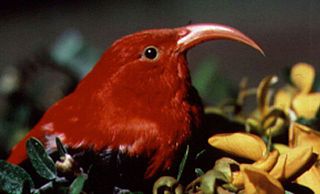
Hawaiian honeycreepers are a group of small birds endemic to Hawaiʻi. They are members of the finch family Fringillidae, closely related to the rosefinches (Carpodacus), but many species have evolved features unlike those present in any other finch. Their great morphological diversity is the result of adaptive radiation in an insular environment. Many have been driven to extinction since the first humans arrived in Hawaii, with extinctions increasing over the last two centuries following European discovery of the islands, with habitat destruction and especially invasive species being the main causes.
